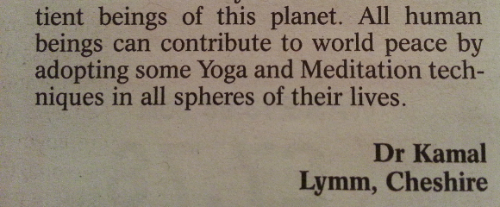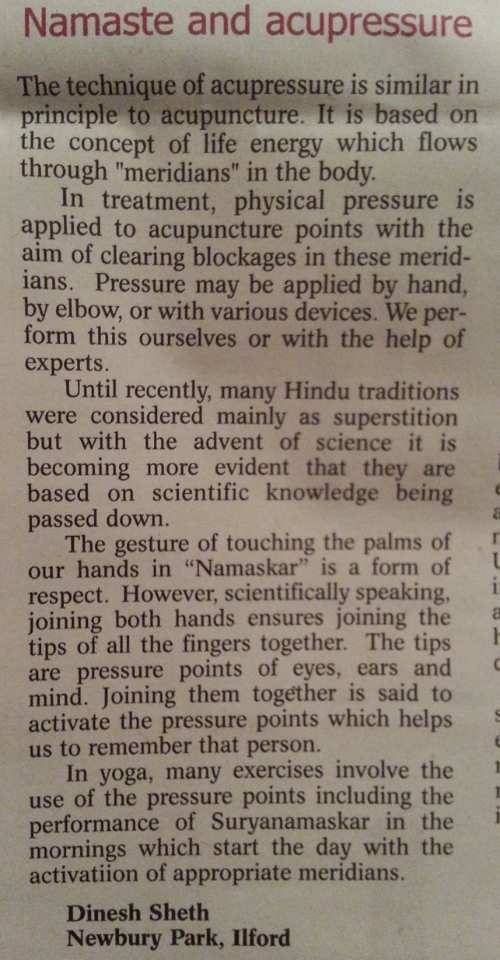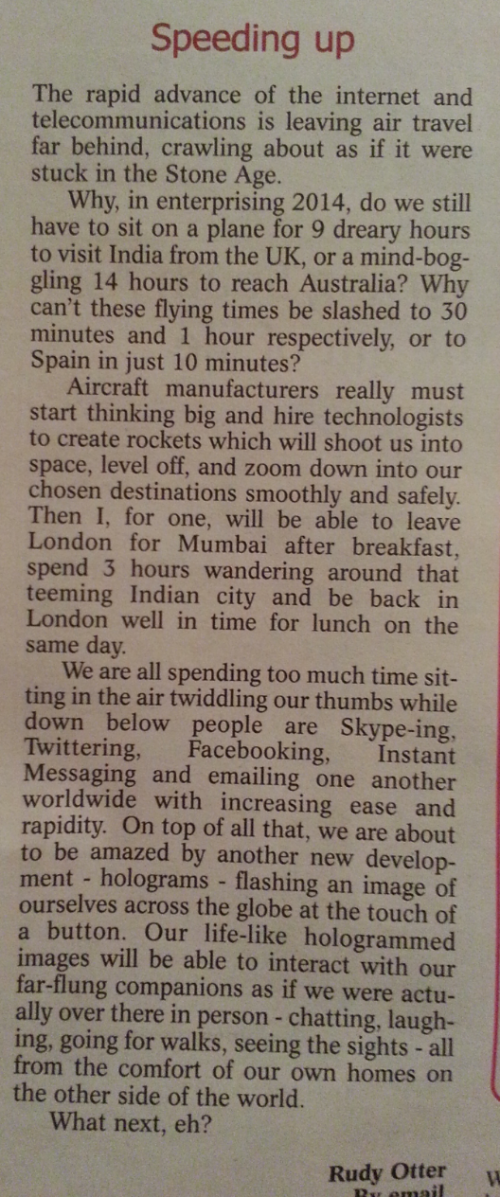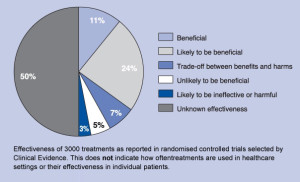August 8th, 2014 § § permalink
First, world peace through the medium of yoga…

Presumably you can’t make war when you’re so twisted up you’re looking up your own sphincter.
Next up, acupressure is science…

Oh, and the tips of your fingers are pressure points for your mind. So it’s not staring at a screen all day that gives me headaches, it’s banging my fingers on that infernal keyboard!
Lastly, some old duffer ponders why it takes half a day to get to Australia…

Yes, aeroplane people, where’s my fucking teleporter?!
November 21st, 2013 § § permalink
Apparently, one of the most misused terms being hurled at What Doctors Don’t Tell You, as a rebuttal, is the term ‘science’.
We have been accused of being unscientific, of pedalling unproven and harmful alternatives, as opposed to the real thing, true ‘scientific’ medicine.
Says Lynne McTaggart. But instead of rebutting the accusations that the stuff contained in WDDTY is at best nonsense, and at worst dangerous, Lynne McTaggart goes on the attack and accuses conventional medicine of not being “remotely scientific”.
To prove her point, Lynne gives three examples of why science is not scientific…
1. Most of the science behind standard treatments is fiction. As leading members of the medical establishment have made clear in recent books, the so-called ‘proof’ of most so-called ‘proven remedies’ is data that has been invented or manipulated by drug company marketing teams.
2. Most treatments haven’t been proven to work. The British Medical Journal has concluded that only about 12 per cent of all medical treatments have adequate evidence demonstrating that they work.
3. Most treatments cause harm. Modern medicine is the third leading cause of death in the western world. Fact. Prescribed drugs and medical error kills 204,000 people every year in America alone, with only cancer and heart disease claiming more
I’m assuming reason one is a reference to Ben Goldacre and his Bad Science and Bad Pharma books. Not being within the Medical Establishment, I don’t know if he is a leading member of it or not. There is undoubtably manipulation of results by the pharmaceutical industry, it could be so much more transparent, with better publication of negative results and other stuff, but to call it all a fiction and for most medicines to not have any proof of er, proof of umm… efficacy? Science?
I’m gonna let Lynne have item number two, as I don’t have the figures to refute the ‘most’ at the beginning of that point. Thanks to a commenter on Lynnes’ post, we can see that there is more than 12% of all medical treatments can demonstrate they work. Lynne doesn’t link to anything to back up her claims. Make of that what you will.
What Lynne is referring to with the ‘12%’ is this. (We’ll not quibble over 1%, eh?)

So, 11% of treatments reported as having beneficial effects. There’s another category, Trade-offs Between Benefits and Harms, with 7%. This one has, if the title is anything to go by, also adequate evidence the treatment works, otherwise the category would be labeled “likely to be…”. These treatments may have side effects, but they are still have benefits. Not possible benefits, but actual benefits.
So that 19% of treatments that do work.
Now, lets explore this curious category of “Unlikely to be beneficial”.
‘Unknown effectiveness’ is perhaps a hard categorisation to explain. Included within it are many treatments that come under the description of complementary medicine
…
‘Unknown effectiveness’ may also simply reflect difficulties in conducting RCTs [Random Controlled Trials] of an intervention…
Considering the difficulties of getting homeopathy and other alternative medicines to consistently return positive results in RCTs then it’s not surprising that they are in the ‘unknown’ category. (Why they’re not in the more negative categories is a long story and not for this post). But if this is the medicine doctors’ won’t tell you vs the medicine doctors will tell you, then you need to take out of the soup of numbers all the alternative medicines and then see what percentage of treatments are beneficial, otherwise, it’s 11% of all treatments, not just the ones proven by the so-called scientific method, which is what Lynne is stating.
Moving on to number three, that most treatments cause harm, is completely unsubstantiated. Lynne states that modern medicine is the leading cause of death of death in the western world is a ridiculous claim. Adding “Fact” after it doesn’t make it one. Apparently the leading cause of death is ischemia and not ‘modern medicine’.
I’ve no idea where Lynne got her figures from for the amount of people killed in the USA by prescribed drugs and medical errors, but the next cause down after heart disease and cancer in America is strokes, with 129,476 deaths.
Next Lynne starts talking about data from the Alliance for Natural Health. Read their views on vaccines and make your own mind up. Reading their opinion on Wakefield and MMR should tell you all you need to know.
Let’s look at so-called ‘unscientific’ natural health care, which supposedly causes so much harm.
Yes, Lynne. Lets look at some more figures.
The risk of dying from taking any herbal remedy or food supplement is around 0.01 per one million people. In other words, 100 million people would have to take a supplement or herb before there is a risk of one person dying because of it.
Compare that to the risk of pharmaceutical drugs, which kill 1000 people for every million people taking them.
So that risk is: 0.01/1 million for natural substances vs 1000/1 million for drugs. In other words, the risk of lethal harm from modern medicine is 100,000 higher than that of herbal or nutritional medicine.
Firstly, Lynne seems to think that ‘herbal remedies’, ‘food supplements’ and ‘natural substances’ seem to be interchangeable. They’re not. Food supplements are different to herbal remedies and ‘natural substances’ is such a vague term it’s meaningless. But I digress. Those figures Lynne quotes are completely meaningless without pitting them against how many people had their condition improved. How many people took drugs and got better compared to how many took drugs and didn’t get better, with the same for alternative treatments. Then you’ll see a meaningful ratio for the effectiveness and risk of the various treatments. I’d be willing to bet, a higher proportion of people may have died from conventional medicine than Complimentary Alternative Medicine (CAM), but CAM would’ve successfully treated a much lower proportion, if any at all.
This beggars the basic question: which form of medicine is the least scientific?
Even with the capitalist manipulation of results from Big Pharma etc, you’ll find CAM is.
Lyne then waffles about science becoming rigid, and closed minded, in the usual way of someone fighting against the conspiracy of Big Pharma – Science has been captured by scientism, and so on.
In this post I have shown that Lynne uses the same techniques she accuses mainstream medicine of using to prove their case. When CAM can be explained, and shown to work using proper random controlled trials and not just anecdote, conjecture and made up words, then it will be taken seriously.
Until then, I’d rather listen to what my doctor does tell me than What Doctors Don’t Tell You tell me.
October 18th, 2010 § § permalink
Part of the series: The Great Travel-Sickness Experiment
The Trip: Abingdon to Newcastle-under-Lyme
Time: approx 2.5 hrs
Miles: approx 125
After having a wierd result from my last trip, the results for my latest experimetation with the accupressure bands is pretty straight forward – no travel sickness at all. None. Nothing.
The only other thing to report is that when I first put a band on my right wrist I must’ve got it in the wrong place, but quickly re-adjusted it as I felt a sharp pain, like a trapped nerve, from my thumb to the inside of my elbow. It disappeared just as quickly when the little button was moved slightly. Apart from that, everything went swimmingly.
So kids, be careful, even homeopathic accupuncture can hurt too.
Result: it’s a good result for the accupressure bands, but not such a good result for ‘Big Pharma’ as my lad, on some Traveleze tablets, puked all over the back of the car after about 2 hours into the journey.
Testing to be continued.
October 13th, 2010 § § permalink
Part of the series: The Great Travel-Sickness Experiment
Finally, a month and a half or so after getting my magic wristbands that are supposed to cure me of travel sickness in our Mazda 5, we went on a trip long enough to give them a proper road test.
The trip: Abingdon to Luton
Time: approx 1.25 hrs
Miles: approx 77
After a bit of messing about with the kids I got the wristbands on after about a mile and a half after we set off. I was already starting to feel a little icky by then and this time felt I didn’t have any problems finding the described place to put them, three finger widths up from the first crease of your wrist, in between the two tendons, unlike the last time I put them on when I couldn’t find two tendons.
The travel sickness feeling didn’t disappear all of a sudden, as I expected it wouldn’t, but slowly morphed into other sensations. By about half way through the journey I realised that I wasn’t feeling sick in the usual way, but urge to nod off was quite strong. It was easy enough to keep my eyes open when looking at road signs or looking at stuff the kids were pointing out, but when there was a lull the natural thing to do was put my head back and close my eyes. There was another sensation as well.
This second sensation started a bit earlier than when I realised I wasn’t actually feeling nauseous and it was while I was thinking about this second sensation that made me notice my steadied guts.
You know when you’re upside down, hanging upside down by your legs from a climbing frame or when you’re laid on the sofa with you feet on the wall and your head dangling just above the floor? Or even when you not quite upside down, maybe laid head-down on the stairs whilst talking face to face with a 3 year old who’s laid head-up on the stairs? After while you head starts to fill with blood. You can feel pressure inside your skull and your eyesballs start to feel like they’re being squeezed. It’s not really a nice feeling at all. That is the sensation I had, but only the eye-ball squeezing part, which I thought was quite weird and completely unexpected.
I can’t quite fit a link between the eye-ball pressure and the pressure of two little nylon buttons pressing on my wrist but I’ve not experienced that pressure in my eyes without being upside down. How can they be connected? Are there veins connected from wrists directly to ones’ eyes?
So in conclusion, whilst wearing the wristbands the need to doze off remained and the nausea was replaced with pressure in the eyes.
Result: inconclusive. More testing required.
I have a trip up to Stoke soon, so we’ll see what happens then.
August 27th, 2010 § § permalink
Part of the series: The Great Travel-Sickness Experiment
I tried my new wristbands today.

It’s was only a short journey of about 9 miles each way. I only had mild motion sickness, but I think that was due to the short journey rather than the wristbands.
They are quite tight on the wrist and even after only 10-15 minutes of wearing there was quite a mark left around my arms, the sort you get round your leg when your sock are too tight, and I wondered if the mark where the nylon bobble was, was actually going to leave a bruise. After 10 minutes or so the marks had disappeared.
When I put the bands on, they felt very tight, as I mentioned previously, and I thought it would annoy and start to itch and stuff, but they didn’t. I think they could on a long journey, though.
Getting the bands in the correct position may be a struggle and will need a bit of trial and error to get right.
You’re supposed to have the bobble three finger widths up your arm from the first wrist crease, and then in between the the tendons. The distance up from my wrist is fairly obvious, but I can only find one tendon. I don’t know if I’m a freak with just one tendon, although everything seems to work ok, it’s hidden behind other stuff or I just don’t know what I’m looking for, but I could only find one.
I think that may be the biggest stumbling block to getting the bands to work correctly, if they do indeed work, is the positioning of them. They need to be in a certain position and you’re trying to get an untrained person to get them in the right place with a basic diagram and short description.
Well, that’s my initial thoughts on them: comfy enough on short distances, not sure if they’re postioned correctly, but they didn’t work. I am not put off though, in my quest to have my head screwed by a cheap bit of woo I shall carry on and try them on a longer journey. Although when that’ll be, I don’t know yet.
February 12th, 2010 § § permalink
Via Gimpy’s blog (this post about homeopaths launching a hate campaign again Dr Evan Harris MP), I ended up at the Homeopathy Heals site. I will admit that I don’t read homeopathic stuff much. Why bother? It’s a load of old wank. I read various skeptics, if that is the right word for these guys that believe medicine should be subjected to proper trials with replicable, provable results, because they’re a good read with various levels of shock/outrage/’wtf-ness’/humour.
I’m not sure why though, but I though I would have a look at this Homeopathy Heals site. There’s nothing here that will surprise you, but anyway here is my tuppence on homeopathy.
You cannot randomly take homeopathic medicines, as they will only work, when carefully selected, for something that needs curing.
(source)
If a medicine has an active ingredient then there will be an effect, whether you are ill or not. That effect may not be the desired one, but there will be an effect. So, just remind me again why no one can overdose on homeopathic medicine?
Of course homeopaths know that one dose of however many pills taken together in one go, is the equivalent of only one dose, because each dose is a stimulus and it is the time frame that counts.
(source)
Oh, of course. The quantity of the supposedly active ingredient doesn’t matter. One dose of homeopathy is one dose when taken as instructed until someone takes large quantities and then they’re still taking only one dose. What is a dose of homeopathy is elastic, depending on how much you are actually taking.
Presumably then, homeopaths only put a teeny-weeny amount of the active ingredient in their medicine not because only a specific amount is needed or too much will be harmful, but to keep costs down.
But if the dose of homeopathy is a stimulus, it kick starts the body into healing itself, then surely a larger quantity of the bollox-in-a-bottle will stimulate more. Once again, this resulting stimulation may have an adverse effect and make someone iller rather than better, but it would have a effect. Wouldn’t you have thought?
According to it’s practitioners homeopathy is has no side effects. It doesn’t matter how much you take you can’t overdose. It is non-addictive, works fast in acute conditions, slow in chronic ones. Safe for everyone including animals and is cheap (apparently). It has, miraculously, no downsides at all.
It all sounds too good to be true, doesn’t it? And we know what they say about things that are too good to be true, don’t we.
Via Le Canard Noir
(all links to the Homeopathy Heals site are rel=”nofollow”)
August 6th, 2009 § § permalink
As a sufferer of mentally bad hayfever as a kid, of which nothing worked to alleviate it, I used to eat local honey. It worked, half of me used to tell myself… and most other people.
The sceptic told me it was bollox. I didn’t know why, just a hunch, y’ know.
Now that last little bit belief has been shattered. I have to own up that maybe, just maybe it wasn’t the honey that did it. Maybe i just grew out of it.
I still get hay fever now and again, just not as bad or for as long. Good job I don’t need my little comforter any more.
Chiropractors. Now that’s a different box of frogs. I’ve had instant, long lasting, positive results from a chiropractor (one that to my knowledge didn’t profess to cure all manner of ills and ailments from coughs to loss of labido, malaria to cancer. There weren’t any leaflets like that anyway), so it’s a little unsettling to read all this stuff about them.
Would I go again? Probably, but I would very very careful about which one.
June 30th, 2009 § § permalink
Jim Barker pointed out a No. 10 Petition (this one, “Maybe this petition explains why ex-pats make such bitter comments on the Daily Mail website”) and after signing it A. Bollockhead, had a look at some more.
This one came up…
We the undersigned petition the Prime Minister to Permit Qualified Aromatherapists and Wiccan Practitioners To Treat Animals.
Why not allow Woo-ists to practice on animals, eh?
Well, in the ‘more detail’ bit the originator of the petition does indeed go in to a bit more detail, but doesn’t really give aromatherapy any more relevence to animals…
The practice of aromatherapy is recorded from Egyptian times, so we can assume that it is probably older than that. References to aromatherapy appear in the famous Ebers Papyrus, which dates from the eighteenth dynasty. The Holy Bible contains many references to the use of oils, in Israel.
All those qualified to us it should be permitted to practice it with animals also.
I don’t doubt the truthfulness of anything that the Karen Stapleton has asserted there, especially as I can’t be arsed to find out, but I don’t think that she or her co-horts in witch-doctory have taken in to account, not just robust investigation in to the effects of their sugar pills, smelly oils and water with memory, but also the ability to fool ourselves which we cannot do to animals…
[Q]uackery might just about be justifiable on humans on the account that the placebo effect might give some relief (although I would argue against taking this position). But an animal cannot experience the placebo and will gain no benefit whatsoever from homeopathy, reiki, or ear candling for that matter. The only person who will gain is the carer, thinking they are doing good for the prickly little fellow. Placebo Effects work on humans. It’s a cultural thing. Hedgehogs do not cotton on to the significance of the psycho-suggestive shamanistic healing rituals involved in homeopathy. They would just prefer to curl up into a pin cushion. Many go on about homeopathy tests on animals proving the case for homeopathy think they do not need to have randomised blind controls, since animals cannot have a placebo effect. But this dodges the fact that it is their carers and owners are reporting the animals’ health improvements – the placebo works on the carers. Blinded trials on animal medicines are still absolutely necessary. For more details on homeopathy, placebos and animals see the excellent British Veterinary Voodoo Society.
I also feel that one of the five other people to sign the petition may have missed the point a little as they’ve signed as…
people should have the choice
March 31st, 2009 § § permalink
The Guardian…
Reiki, an alternative Japanese therapy with a growing band of followers in the west, is “unscientific” and “inappropriate” for use in Catholic institutions, according to America’s bishops.
Guidelines issued by the committee on doctrine at the United States Conference of Catholic Bishops warn healthcare workers and chaplains that the therapy “lacks scientific credibility” and could expose people to “malevolent forces”.
The document also claims that for a Catholic to believe in reiki presents “insurmountable problems”.
Bwahahahahaha! An organisation that is built on the myth and legend with no scientific evidence, is scared that some of its’ members might fall for a different set myths and legends that have no scientific evidence.
Ooh, molevolent forces…
…a notion which is of course hugely credible and strongly supported by scientists, particularly those working in Malevolent Forces and Evil Spirits research departments around the world.
And, again from the New Humanist, in the interest of balance…
New Humanist was unable to find a reiki practitioner to comment on the scientific credibility of the Vatican stance on condoms and the spread of HIV…
Via D-Notice






